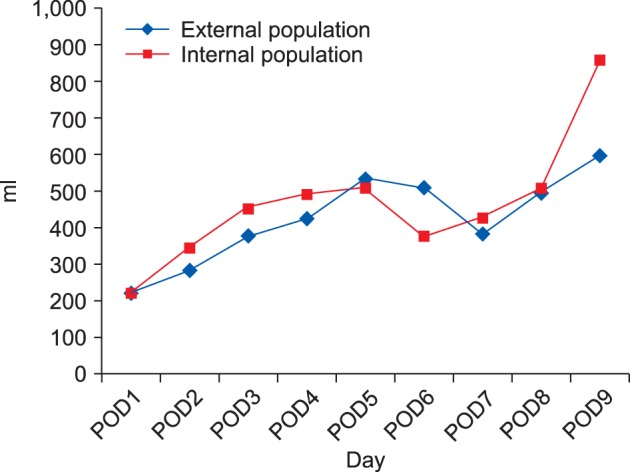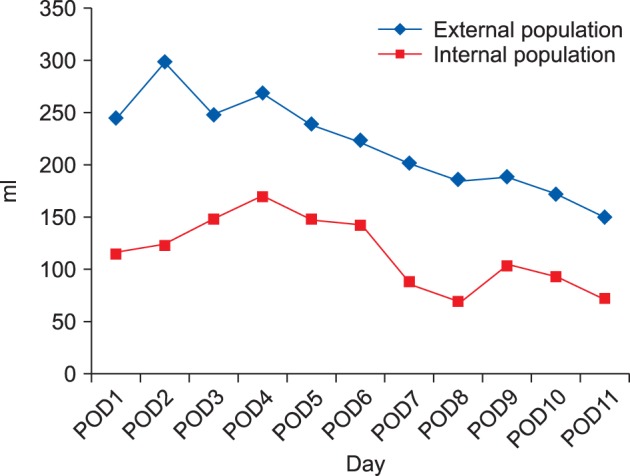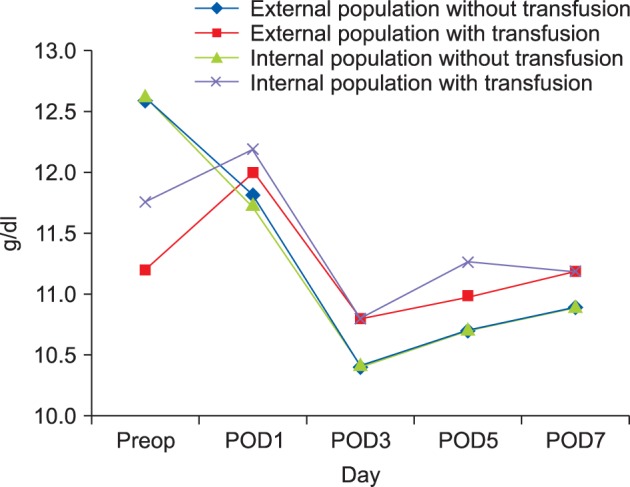Korean J Hepatobiliary Pancreat Surg.
2016 Feb;20(1):23-31. 10.14701/kjhbps.2016.20.1.23.
Postoperative biological and clinical outcomes following uncomplicated pancreaticoduodenectomy
- Affiliations
-
- 1Service de Chirurgie digestive, Hopital universitaire d'Angers - Universite d'Angers, France.
- 2Digestive surgery, Hospital of Kunming - Medical University - Kunming - China.
- 3Service de Chirurgie Hepatobiliopancreatique, Hopital Beaujon - Universite Paris VII, France.
- 4Service de Chirurgie digestive et oncologique, Hopital Claude Huriez - Universite de Lille, France.
- 5Service de Chirurgie generale et digestive, Hopital Saint-antoine - UPMC Paris VI, France.
- 6Service de Chirurgie digestive et de transplantation, Hopital Rangueil - Universite de Toulouse, France.
- 7Service de Chirurgie digestive, Hopital Haut Leveque - Universite de Bordeaux, France.
- 8Service de Chirurgie digestive, Hopital de la Timone - Universite de Marseille, France.
- 9Unite de Chirurgie Hepatobiliaire et Pancreatique, Nouvel Hopital Civil, Universite de Strasbourg, IHU MixSurg, IRCAD, France. patrick.pessaux@chru-strasbourg.fr
- KMID: 2243028
- DOI: http://doi.org/10.14701/kjhbps.2016.20.1.23
Abstract
- BACKGROUNDS/AIMS
The aim of this study was to describe clinical and biological changes in a group of patients who underwent pancreaticoduodenectomy (PD) without any complication during the postoperative period. These changes reflect the "natural history" of PD, and a deviation should be considered as a warning sign.
METHODS
Between January 2000 and December 2009, 131 patients underwent PD. We prospectively collected and retrospectively analyzed demographic data, pathological variables, associated pathological conditions, and preoperative, intraoperative, and postoperative variables. Postoperative variables were validated using an external prospective database of 158 patients.
RESULTS
The mean postoperative length of hospital stay was 20.3+/-4 days. The mean number of days until removal of nasogastric tube was 6.3+/-1.6 days. The maximal fall in hemoglobin level occurred on day 3 and began to increase after postoperative day (POD) 5, in patients with or without transfusions. The white blood cell count increased on POD 1 and persisted until POD 7. There was a marked rise in aminotransferase levels at POD 3. The peak was significantly higher in patients with hepatic pedicle occlusion (866+/-236 IU/L versus 146+/-48 IU/L; p<0.001). For both gamma-glutamyl transpeptidase and alkaline phosphatase, there was a fall on POD1, which persisted until POD 5, followed with a stabilization. Bilirubin decreased progressively from POD 1 onwards.
CONCLUSIONS
This study facilitates a standardized biological and clinical pathway of follow-up. Patients who do not follow this recovery indicator could be at risk of complications and additional exams should be made to prevent consequences of such complications.
MeSH Terms
Figure
Reference
-
1. Whipple AO, Parsons WB, Mullins CR. Treatment of carcinoma of the ampulla of vater. Ann Surg. 1935; 102:763–779. PMID: 17856666.2. Crile G Jr. The advantages of bypass operations over radical pancreatoduodenectomy in the treatment of pancreatic carcinoma. Surg Gynecol Obstet. 1970; 130:1049–1053. PMID: 4192028.3. Shapiro TM. Adenocarcinoma of the pancreas: a statistical analysis of biliary bypass vs Whipple resection in good risk patients. Ann Surg. 1975; 182:715–721. PMID: 1190874.4. Cameron JL, Riall TS, Coleman J, Belcher KA. One thousand consecutive pancreaticoduodenectomies. Ann Surg. 2006; 244:10–15. PMID: 16794383.
Article5. Trede M, Schwall G, Saeger HD. Survival after pancreatoduodenectomy. 118 consecutive resections without an operative mortality. Ann Surg. 1990; 211:447–458. PMID: 2322039.6. Pessaux P, Varma D, Arnaud JP. Pancreaticoduodenectomy: superior mesenteric artery first approach. J Gastrointest Surg. 2006; 10:607–611. PMID: 16627229.
Article7. Sastre B, Ouassi M, Pirro N, Cosentino B, Sielezneff I. Pancreaticoduodenectomy in the era of evidence based medicine. Ann Chir. 2005; 130:295–302. PMID: 15935785.8. Yeo CJ, Barry MK, Sauter PK, Sostre S, Lillemoe KD, Pitt HA, et al. Erythromycin accelerates gastric emptying after pancreaticoduodenectomy. A prospective, randomized, placebo-controlled trial. Ann Surg. 1993; 218:229–237. PMID: 8103982.9. Ohwada S, Satoh Y, Kawate S, Yamada T, Kawamura O, Koyama T, et al. Low-dose erythromycin reduces delayed gastric emptying and improves gastric motility after Billroth I pylorus-preserving pancreaticoduodenectomy. Ann Surg. 2001; 234:668–674. PMID: 11685031.
Article10. Martin C. The use of microbial prophylaxis in visceral surgery. Update 1999. J Chir (Paris). 1999; 136:211–215. PMID: 10615589.11. Bruno O, Brancatelli G, Sauvanet A, Vullierme MP, Barrau V, Vilgrain V. Utility of CT in the diagnosis of pancreatic fistula after pancreaticoduodenectomy in patients with soft pancreas. AJR Am J Roentgenol. 2009; 193:W175–W180. PMID: 19696255.
Article12. Dindo D, Demartines N, Clavien PA. Classification of surgical complications: a new proposal with evaluation in a cohort of 6336 patients and results of a survey. Ann Surg. 2004; 240:205–213. PMID: 15273542.13. Mandell LA, Wunderink RG, Anzueto A, Bartlett JG, Campbell GD, Dean NC, et al. Infectious Diseases Society of America. American Thoracic Society. Infectious Diseases Society of America/American Thoracic Society consensus guidelines on the management of community-acquired pneumonia in adults. Clin Infect Dis. 2007; 1. 44(Suppl 2):S27–S72. PMID: 17278083.
Article14. Rotstein C, Evans G, Born A, Grossman R, Light RB, Magder S, et al. Clinical practice guidelines for hospital-acquired pneumonia and ventilator-associated pneumonia in adults. Can J Infect Dis Med Microbiol. 2008; 19:19–53. PMID: 19145262.
Article15. Torres A. American Thoracic Society. Infectious Disease Society of North America. The new American Thoracic Society/Infectious Disease Society of North America guidelines for the management of hospital-acquired, ventilator-associated and healthcare-associated pneumonia: a current view and new complementary information. Curr Opin Crit Care. 2006; 12:444–445. PMID: 16943723.
Article16. Bassi C, Dervenis C, Butturini G, Fingerhut A, Yeo C, Izbicki J, et al. International Study Group on Pancreatic Fistula Definition.Postoperative pancreatic fistula: an international study group (ISGPF) definition. Surgery. 2005; 138:8–13. PMID: 16003309.
Article17. Wente MN, Bassi C, Dervenis C, Fingerhut A, Gouma DJ, Izbicki JR, et al. Delayed gastric emptying (DGE) after pancreatic surgery: a suggested definition by the International Study Group of Pancreatic Surgery (ISGPS). Surgery. 2007; 142:761–768. PMID: 17981197.
Article18. Wente MN, Veit JA, Bassi C, Dervenis C, Fingerhut A, Gouma DJ, et al. Postpancreatectomy hemorrhage (PPH): an International Study Group of Pancreatic Surgery (ISGPS) definition. Surgery. 2007; 142:20–25. PMID: 17629996.19. Pessaux P, Sauvanet A, Mariette C, Paye F, Muscari F, Cunha AS, et al. Fédération de Recherche en Chirurgie (French). External pancreatic duct stent decreases pancreatic fistula rate after pancreaticoduodenectomy: prospective multicenter randomized trial. Ann Surg. 2011; 253:879–885. PMID: 21368658.20. Sosa JA, Bowman HM, Gordon TA, Bass EB, Yeo CJ, Lillemoe KD, et al. Importance of hospital volume in the overall management of pancreatic cancer. Ann Surg. 1998; 228:429–438. PMID: 9742926.
Article21. Gouma DJ, van Geenen RC, van Gulik TM, de Haan RJ, de Wit LT, Busch OR, et al. Rates of complications and death after pancreaticoduodenectomy: risk factors and the impact of hospital volume. Ann Surg. 2000; 232:786–795. PMID: 11088073.
Article22. Cameron JL, Pitt HA, Yeo CJ, Lillemoe KD, Kaufman HS, Coleman J. One hundred and forty-five consecutive pancreaticoduodenectomies without mortality. Ann Surg. 1993; 217:430–435. PMID: 8098202.
Article23. Yeo CJ, Cameron JL, Sohn TA, Lillemoe KD, Pitt HA, Talamini MA, et al. Six hundred fifty consecutive pancreaticoduodenectomies in the 1990s: pathology, complications, and outcomes. Ann Surg. 1997; 226:248–257. PMID: 9339931.24. Birkmeyer JD, Warshaw AL, Finlayson SR, Grove MR, Tosteson AN. Relationship between hospital volume and late survival after pancreaticoduodenectomy. Surgery. 1999; 126:178–183. PMID: 10455881.
Article25. Birkmeyer JD, Stukel TA, Siewers AE, Goodney PP, Wennberg DE, Lucas FL. Surgeon volume and operative mortality in the United States. N Engl J Med. 2003; 349:2117–2127. PMID: 14645640.
Article26. Bassi C, Butturini G, Molinari E, Mascetta G, Salvia R, Falconi M, et al. Pancreatic fistula rate after pancreatic resection. The importance of definitions. Dig Surg. 2004; 21:54–59. PMID: 14707394.27. Lermite E, Sommacale D, Piardi T, Arnaud JP, Sauvanet A, Dejong CH, et al. Complications after pancreatic resection: diagnosis, prevention and management. Clin Res Hepatol Gastroenterol. 2013; 37:230–239. PMID: 23415988.
Article28. Fernández-del Castillo C, Rattner DW, Warshaw AL. Standards for pancreatic resection in the 1990s. Arch Surg. 1995; 130:295–299. PMID: 7887797.
Article29. Brooks AD, Marcus SG, Gradek C, Newman E, Shamamian P, Gouge TH, et al. Decreasing length of stay after pancreatoduodenectomy. Arch Surg. 2000; 135:823–830. PMID: 10896377.
Article30. Salvia R, Malleo G, Butturini G, Dal Molin M, Esposito A, Marchegiani G, et al. Perioperative management of patients undergoing pancreatic resection: implementation of a care plan in a tertiary-care center. J Surg Oncol. 2013; 107:51–57. PMID: 23129003.
Article31. di Sebastiano P, Festa L, De Bonis A, Ciuffreda A, Valvano MR, Andriulli A, et al. A modified fast-track program for pancreatic surgery: a prospective single-center experience. Langenbecks Arch Surg. 2011; 396:345–351. PMID: 20703500.
Article32. Suc B, Panis Y, Belghiti J, Fékété F. 'Natural history' of hepatectomy. Br J Surg. 1992; 79:39–42. PMID: 1346582.
Article33. Shankar S, Russell RC. Haemorrhage in pancreatic disease. Br J Surg. 1989; 76:863–866. PMID: 2765846.
Article34. Blanc T, Cortes A, Goere D, Sibert A, Pessaux P, Belghiti J, et al. Hemorrhage after pancreaticoduodenectomy: when is surgery still indicated? Am J Surg. 2007; 194:3–9. PMID: 17560900.
Article35. Brodsky JT, Turnbull AD. Arterial hemorrhage after pancreatoduodenectomy. The 'sentinel bleed'. Arch Surg. 1991; 126:1037–1040. PMID: 1863209.36. de Castro SM, Kuhlmann KF, Busch OR, van Delden OM, Laméris JS, van Gulik TM, et al. Delayed massive hemorrhage after pancreatic and biliary surgery: embolization or surgery? Ann Surg. 2005; 241:85–91. PMID: 15621995.
Article37. Koyama K, Takagi Y, Ito K, Sato T. Experimental and clinical studies on the effect of biliary drainage in obstructive jaundice. Am J Surg. 1981; 142:293–299. PMID: 6789695.
Article38. Hunt DR, Allison ME, Prentice CR, Blumgart LH. Endotoxemia, disturbance of coagulation, and obstructive jaundice. Am J Surg. 1982; 144:325–329. PMID: 7114371.
Article39. Fan ST, Lo CM, Lai EC, Yu WC, Wong J. T lymphocyte function in patients with malignant biliary obstruction. J Gastroenterol Hepatol. 1994; 9:391–395. PMID: 7948822.
Article
- Full Text Links
- Actions
-
Cited
- CITED
-
- Close
- Share
- Similar articles
-
- Clinical Outcomes of Pancreaticoduodenectomy in Children
- Correlations between the Rate of Decrease in Preoperative Bilirubin and Postoperative Complications after Biliary Drainage for Distal Common Bile Duct Cancer
- Training in the Japanese Society of Hepato-Biliary-Pancreatic Surgery board certification system for expert surgeons during 225 consecutive pancreaticoduodenectomies
- Unfavorable effect of high postoperative fluid balance on outcome of pancreaticoduodenectomy
- A case series of emergency pancreaticoduodenectomies: What were their indications and outcomes?




